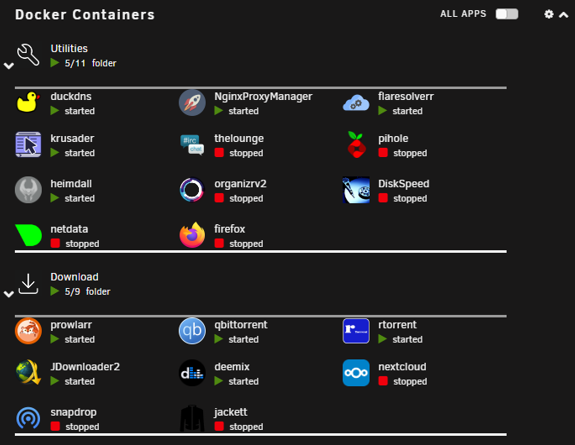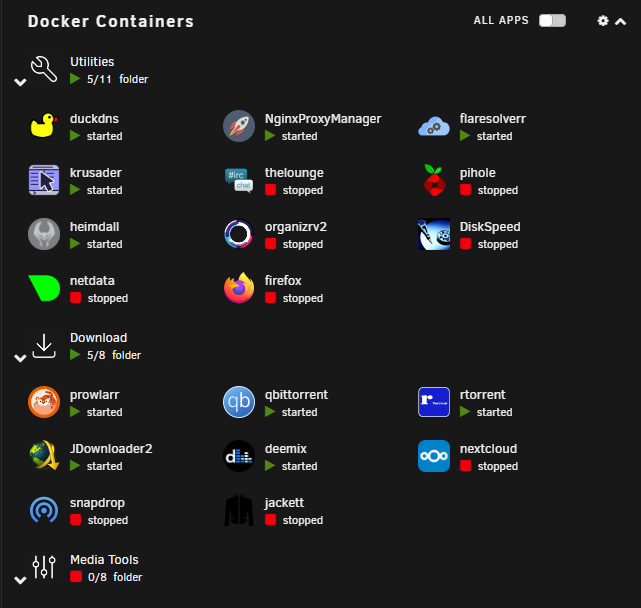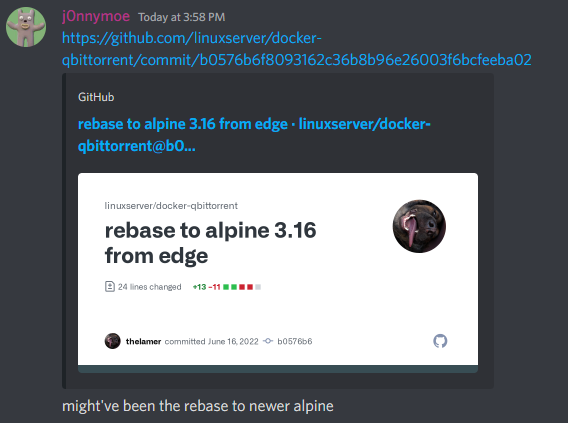-
Posts
225 -
Joined
-
Last visited
Content Type
Profiles
Forums
Downloads
Store
Gallery
Bug Reports
Documentation
Landing
Posts posted by Linguafoeda
-
-
On 11/6/2022 at 6:57 PM, Linguafoeda said:
No worries, wasn't sure if i had missed a setting somewhere to re-enable it. Thanks so much for your work getting this to work with latest unraid. Last question - is there a way to fix the rendering issues with the dashboard on iPad/iOS devices? It shows up with a bunch of random spaces (see below screenshot from an iPad Pro 13")
@thecode any chance you were able to look into what's causing this weird spacing issue in GUI for iPad?
-
On 12/8/2022 at 3:56 AM, Linguafoeda said:
I'm trying to rollback to binhex/arch-qbittorrentvpn:4.4.5-2-02 (a tracker i use has been slow about whitelisting 4.5) but i have the fire logo with my current VPN (Windscribe) indicating it cannot connect. What am i doing wrong that my old qbit 4.4.5 won't connect anymore? I tried deleting the wg0 file in the wireguard folder and re-putting the .conf file downloaded from Windscribe into the wireguard appdata folder and relaunching qbit but it doesn't work. If i roll into the latest (i.e. binhex/arch-qbittorrentvpn), then it works fine but then multiple torrents won't seed / download from this specific tracker 😕
bump
-
I'm trying to rollback to binhex/arch-qbittorrentvpn:4.4.5-2-02 (a tracker i use has been slow about whitelisting 4.5) but i have the fire logo with my current VPN (Windscribe) indicating it cannot connect. What am i doing wrong that my old qbit 4.4.5 won't connect anymore? I tried deleting the wg0 file in the wireguard folder and re-putting the .conf file downloaded from Windscribe into the wireguard appdata folder and relaunching qbit but it doesn't work. If i roll into the latest (i.e. binhex/arch-qbittorrentvpn), then it works fine but then multiple torrents won't seed / download from this specific tracker 😕
-
On 9/11/2020 at 8:22 PM, AceRimmer said:
Feature suggestion (if it hasn't been suggested yet)
Re-order VPN peers the same way i can re-order VM's (hold click, drag & drop).
i'd like to see this too. i'm on 6.11.3
-
Does anyone know how to preserve the column settings/widths etc of the UI of qbittorrent so it's not dependent on the local cookie of the browser accessing? I sometimes clear cookies out of my browser which resets my qbittorrent view...
-
2 minutes ago, thecode said:
I have removed them in 6.11, see https://github.com/Squidly271/docker.folder/pull/3 for details, they were broken, couldn't get them to work correctly, so you may left with lines that stay stuck on the dashboard....
Code for drawing them is still there, if anyone have time to fix it, let me know. I may return to this in the future if I have time
No worries, wasn't sure if i had missed a setting somewhere to re-enable it. Thanks so much for your work getting this to work with latest unraid. Last question - is there a way to fix the rendering issues with the dashboard on iPad/iOS devices? It shows up with a bunch of random spaces (see below screenshot from an iPad Pro 13")
-
3 minutes ago, thecode said:
Short answer would be from a flash drive backup (which you should do periodically anyhow)
Long answer, there is no simple way to recover it, you can follow the steps here
Flash should be FAT so many tools can undelete files from there, I am not sure it worth the effort
I was able to re-find some of the custom icons i had for folders, so i just reset my folders up. Thanks for the help. Any idea how to get the "white divider" lines back on the main dashboard page? that's only thing i can't seem to find
Before:

After:

-
i uninstalled the old docker folder to install squid repo for 6.11 and lost all my settings. is there any way to get this back?

-
21 hours ago, Linguafoeda said:
bump - does anyone know what’s going on here? I had to roll back to 4.3.9 to fix this. Wasn’t having this issue at all 2 days ago when I was running 6.11.0 Unraid / latest binhex qbt container. Is there some setting I’m missing that is causing qbit to use all my resources?Docker Folder I believe is what allows the individual monitoring in 2nd screenshot btw.
.
-
-
On 10/3/2022 at 9:55 PM, Linguafoeda said:
Could someone tell me how I can setup Windscribe VPN with this container? I'm a bit confused as I see the template having Key 4: PIA, AirVPN, Custom and Key 5: openVPN / wireguard. I heard Wireguard is the optimal protocol for speed, do i need to just put in my windscribe username/password in Key 2 (vpn username) and key 3 (vpn password) and select wireguard?
Also how do i enable the client to exclusively use VPN i.e. bind the qbit client to the adapter with VPN? I believe this is separate from "kill switches" built into the VPN itself. I want to make sure there's no possibility of leakage of IP
So i followed the guide in this video and used the KEY 4= custom and KEY 5 = wireguard and generated wireguard .conf files for Windscribe from here and placed them in /mnt/cache/appdata/binhex-qbittorrentvpn/wireguard/. When i right click on the container -> command line and run "curl ifconfig.io", it is showing an IP related to the VPN location i selected from that wireguard configurator. Does that mean everything for VPN is setup and fully running? I tried a test Ubuntu torrent and it peaked at around 80MB/s which seems pretty good for my gig connection.
I want to make sure my torrent client is bound so that there is no IP leakage. When I googled this, people universally recommended that I need to go into Qbittorrent settings -> advanced -> network interface and select the VPN interface to permanently bind it. Does anyone know which one I need to select (i see "lo", "wg0" and "eth0")? Or is this automatically already done via the container and I don't need any further tweaking to prevent ip leakage (I saw a reddit comment here referencing iptables saying it's already "implemented")
-
Could someone tell me how I can setup Windscribe VPN with this container? I'm a bit confused as I see the template having Key 4: PIA, AirVPN, Custom and Key 5: openVPN / wireguard. I heard Wireguard is the optimal protocol for speed, do i need to just put in my windscribe username/password in Key 2 (vpn username) and key 3 (vpn password) and select wireguard?
Also how do i enable the client to exclusively use VPN i.e. bind the qbit client to the adapter with VPN? I believe this is separate from "kill switches" built into the VPN itself. I want to make sure there's no possibility of leakage of IP
-
On 8/13/2022 at 9:00 AM, Azarog said:
i'm pretty sure it's normal as you should cron schedule start it because it syncs at startup i think
If you want PlexTraktSync to watch / actively scrobble, are you meant to add "watch" to either your container template post argument or as a separate line in the script? Referencing this part of the setup
I have a cron setup as custom at 4a daily (0 4 * * *):
#!/bin/bash docker start PlexTraktSync -
On 11/3/2021 at 5:40 PM, fnwc said:
For anyone reading this, I managed to solve it by pulling the github repo, https://github.com/Taxel/PlexTraktSync, installing Python, and running "python main.py" directly to run the authentication process, which creates the .env and .pytrakt.json files. Then I copied the created .env and .pytrakt.json files to the docker filesystem in the same directory.Actually, I'm not able to access the filesystem without starting the docker, and I can't start the docker in interactive mode (in order to enter my auth information) through the Unraid GUI. So, instead, enter the terminal for your Unraid server, type "docker image ls", find the docker ID of the container, then type "docker run -it <docker_ID>" of the docker ID you found.
This will allow you to configure the docker as needed to create the .env and .pytrakt.json files.
thank you so much for this!
-
hmm anyone else know the native way? There should be one right?
-
Hello - I was wondering if anyone had a tutorial on how to setup a VPN (in this case, PIA) with a LinuxServer container such as Qbittorrent (lscr.io/linuxserver/qbittorrent).
I know there is a Binhex container for QbittorrentVPN but I would like to learn how to use a third-party VPN (i.e. PIA / NordVPN / Mullvad etc.) to integrate with various containers that don't have VPN built in (because eventually i will want to setup VPN-only access for a bunch of containers though first priority is just getting my qbittorrent client setup).
I asked in the LinuxServer discord and they pointed me towards this link but i don't really follow it at all as it relates to how to replicate this functionality with the built-in Unraid GUI (i.e. VPN Manager in settings or editing linuxserver's qbit container variables). I also want to make sure the qbit interface is bound to the VPN so there is no potential for leak of my existing IP (i.e. fullproof from getting notices from ISP).
Anyone have a tutorial on how to get VPN working on non-binhex related containers like LinuxServer's Qbittorrent?
-
does anyone have instructions on how to make linuxserver's qbittorrent route all traffic through PIA VPN in Unraid? Trying to understand how to do this without using the binhex docker as i would like to learn this step for other linuxserver containers later on
-
Hello - I'm thinking of signing up for PIA VPN (its $79 for 39 months which is pretty good deal).
How do I edit the docker template to make sure that qbit only runs when vpn is active / "kill switch" works without any leaks? Want to protect against my internet provider knowing anything about what I'm DL'ing.
-
according to the GitHub thread, the issue has been fixed in the latest commit.
-
8 hours ago, PSYCHOPATHiO said:
@Linguafoeda unfrotunatly I'm here for this issue, it's very annoying to set permissions for everydownload i need to change.
How to do a rollback?
Edit docker and change the repository to "lscr.io/linuxserver/qbittorrent:4.4.3.1-r1-ls200"-
 1
1
-
 1
1
-
-
9 hours ago, PSYCHOPATHiO said:
Latest update broke permission on the torrent directory, I have to chmod the directory if i need to remove or do changes to downloaded files.
"-e UMASK=000" or "UMASK 002" both no longer work I have tried everything to fix the permissions but nothing worked.
ah damn i'm having the same issue too. any idea what could fix this or if there is an alternative way for files created by qbit docker to be editable when accessed via Windows mounted shares? running docker safe new perms every time i download a file is really cumbersome. The github issue is located here for reference.
edit: I guess a stop-gap for now is rolling back to the old version of "lscr.io/linuxserver/qbittorrent:4.4.3.1-r1-ls200". According to discord server, the issue may be related to ls203 commit update which changed the below.

-
 1
1
-
-
#### What is the problem you are having with rclone?
I am running Unraid and everytime a log file is created from the command I'm trying to log, it defaults with no linux permissions which doesn't allow me to read/write the .txt file generated. Any idea how to make it so that the default permissions given is RW so i can access the log file via Krusader or windows mounted samba share? The terminal is running as "root@Unraid:~#" for reference.rclone sync --transfers 8 --checkers 16 --progress --delete-during --no-update-modtime --contimeout 60s --timeout 300s --retries 3 --low-level-retries 10 --drive-chunk-size=64M --drive-upload-cutoff=64M --stats 1s --stats-file-name-length 0 --fast-list --drive-acknowledge-abuse --log-level DEBUG --log-file=/mnt/user/Personal/Logs/rclone_$(date +%Y%m%d_%H%M%S).txt "/mnt/user/MOV" "GD:GD/MOV"#### Run the command 'rclone version' and share the full output of the command.
rclone v1.58.0- os/version: slackware 14.2+ (64 bit)- os/kernel: 5.10.28-Unraid (x86_64)
- os/type: linux
- os/arch: amd64
- go/version: go1.17.8
- go/linking: static
- go/tags: none -
so for reference, did this with another server. here's the instructions I referenced: current system has 3x14TB drives and 2x8TB drives and no parity. Want to replace both the 8TB drives with a 18TB drive. what steps do i need to follow to move all the files off the two 8TB's to put them on my newly bought 18TB drive and make sure all my docker/everything works fine when i startup array again (I want the 18TB disk to be labeled "disk #4 vs. my 8TB are disk #4 and disk #5 today):
1. insert new 18TB drive into physical slot #6, stop array, assign 18TB drive as disk #6 into array
2. start array, format 18TB disk in array as XFS
3. open unbalance, PLAN then COPY all files from Disk #4 (8TB) and Disk #5 (8TB)
4. stop docker service in settings, stock VM service in settings, stop mover service
5. Stop array, remove disk #4 & Disk #5 from array, physically remove Slot #4 and Slot #5 drives (both 8TB drives), move new 18TB disk from slot #6 to Slot #4
6. Run new config process ("select all"; note this resets any custom settings like temperature for all disks!), then go back to Main and add 18TB drive as Disk #4
7. Change share settings that previously included Disk #4 & Disk #5 of the old 8TB drives to include Disk #4 (new 18TB drive is now Disk #4)
8. Restart docker / VM / Mover services -
On 5/15/2022 at 10:41 PM, Linguafoeda said:
anyone know how to do this (I don't have an external GPU)? I used opencore configuration -> Tools -> Mount EFI -> Mount Partition / Open Partition -> navigate to "EFI/OC/config.plist" and opened in BBEdit. Below is what I get. I'm looking for a way to be able to switch resolutions dynamically within the system settings (i.e. from 1920x1080 to 2048x1536 based on when i'm remoting in from my ipad vs. my desktop PC).<key>Output</key> <dict> <key>ClearScreenOnModeSwitch</key> <false/> <key>ConsoleMode</key> <string></string> <key>DirectGopRendering</key> <false/> <key>ForceResolution</key> <false/> <key>IgnoreTextInGraphics</key> <false/> <key>ProvideConsoleGop</key> <true/> <key>ReconnectOnResChange</key> <false/> <key>ReplaceTabWithSpace</key> <false/> <key>Resolution</key> <string>Max</string> <key>SanitiseClearScreen</key> <false/> <key>TextRenderer</key> <string>BuiltinGraphics</string> <key>UgaPassThrough</key> <false/> </dict>
Bump - is there a way to setup multiple resolutions so that I don't need to mess with opencore config whenever i want to switch between say 1920x1080 to 2048x1536?











[Support] binhex - Krusader
in Docker Containers
Posted · Edited by Linguafoeda
does anyone know if there is a way to locally access "mediaInfo" for media files within Krusader? It's cumbersome to open a separate MediaInfo docker container and manually open each file vs. being able to pull the MediaInfo directly in Krusader. I quickly googled but only found the below. is it possible even to install this within binhex's krusader on unraid? If so, could someone tell me how to?
https://store.kde.org/p/1418250